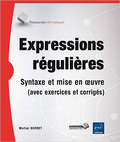GNU/Linux man pages
Livre :
Expressions régulières,
Syntaxe et mise en oeuvre :


GNU/Linux |
Ubuntu 9.04(Jaunty Jackalope) |
|
 |
lockfile-remove(1) |
 |
lockfile−progs − command−line programs to safely lock and unlock files and mailboxes (via liblockfile).
mail−lock
[ −−retry retry−count ]
mail−unlock
mail−touchlock [ −−oneshot ]
lockfile−create
[ −−retry retry−count ]
filename
lockfile−remove filename
lockfile−touch [ −−oneshot ]
filename
lockfile−progs provide a method to lock and unlock mailboxes and files safely (via liblockfile).
By default, the filename argument refers to the name of the file to be locked, and the name of the lockfile will be filename .lock. However, if the −−lock-name argument is specified, then filename will be taken as the name of the lockfile itself.
mail−lock:
lock the current user’s mailbox.
mail−unlock: unlock the current user’s
mailbox.
mail−touchlock: touch the lock on the current
user’s mailbox.
Each of the mail locking commands is applied to the file /var/spool/mail/<user>, if possible, where <user> is the name of the current user (determined from the effective uid via geteuid(2)).
lockfile−create:
lock a given file.
lockfile−remove: remove the lock on a given file.
lockfile−touch: touch the lock on a given
file.
Once a file is locked, the lock must be touched at least once every five minutes, or it will be considered stale and a subsequent attempt to lock the file will succeed. For both of the locking commands (mail−touchlock and lockfile−touch), the −−oneshot argument causes the program to touch the lock and exit immediately. Otherwise the program will loop forever, touching the lock once every minute until it is killed.
For both of the locking commands (mail−lock and lockfile−create), the −−retry argument specifies (as an integer) the maximum number of times to retry locking the file before giving up if attempts are failing. Each retry will be delayed a little longer than the last (in 5 second increments) until a maximum delay of one minute between retries is reached. The default retry count is 9 which, if all 9 attempts to lock the file fail, will give up after 180 seconds (3 minutes).
The
lockfile−create, lockfile−remove,
and lockfile-touch commands will also accept these
options:
−l, −−lock-name
Use filename as the explict lock file name instead of appending .lock to filename.
All of the
following commands will accept these options:
−q, −−quiet
Supress any output. Success or failure will only be indicated by the exit status.
−v, −−verbose
Enable diagnostic output.
Locking a file during a lengthy process:
lockfile−create
/some/file
lockfile−touch /some/file &
# Save the PID of the lockfile−touch process
BADGER="$!"
do−something−important−with /some/file
kill "${BADGER}"
lockfile−remove /some/file
|
0 |
Successful program execution. |
ANYTHING ELSE
Some problem was encountered.
maillock(3)
touchlock(3)
mailunlock(3)
lockfile−create(1)
lockfile−remove(1)
lockfile−touch(1)
lockfile_create(3)
lockfile_remove(3)
lockfile_touch(3)
1998 − Written by Rob Browning <rlb@defaultvalue.org>.
 |
lockfile-remove(1) |  |